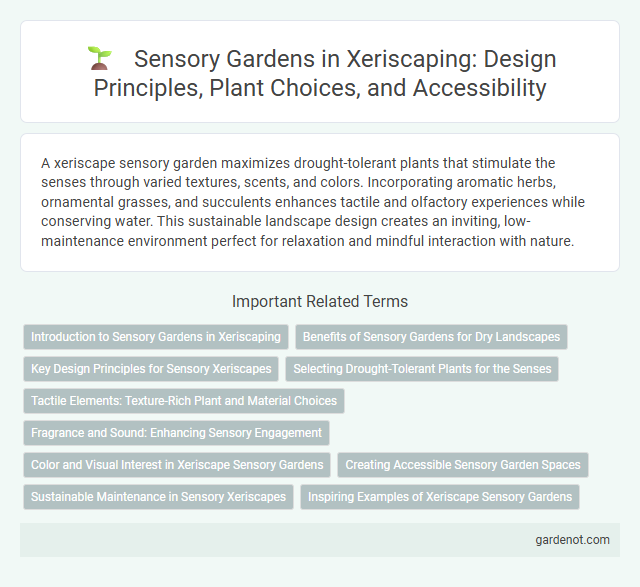A xeriscape sensory garden maximizes drought-tolerant plants that stimulate the senses through varied textures, scents, and colors. Incorporating aromatic herbs, ornamental grasses, and succulents enhances tactile and olfactory experiences while conserving water. This sustainable landscape design creates an inviting, low-maintenance environment perfect for relaxation and mindful interaction with nature.
Introduction to Sensory Gardens in Xeriscaping
Sensory gardens in xeriscaping integrate drought-tolerant plants with diverse textures, colors, and fragrances to stimulate sight, smell, touch, and sound while conserving water. Strategic use of native succulents, ornamental grasses, and fragrant herbs creates an engaging, low-maintenance landscape that enhances accessibility and sensory experiences. These water-efficient gardens support sustainable landscaping by reducing irrigation needs and promoting biodiversity in arid environments.
Benefits of Sensory Gardens for Dry Landscapes
Sensory gardens designed for xeriscape environments enhance accessibility by incorporating drought-tolerant plants that stimulate sight, touch, smell, and hearing without excessive water use. These gardens provide ecological benefits, supporting local pollinators and improving soil health in arid conditions. By using native, low-water species such as lavender, ornamental grasses, and succulents, sensory gardens contribute to sustainable landscaping while promoting mental well-being and relaxation.
Key Design Principles for Sensory Xeriscapes
Sensory xeriscapes incorporate drought-tolerant plants with varied textures, colors, and scents to engage multiple senses while conserving water. Key design principles emphasize selecting native species adapted to arid climates, layering plants for tactile and visual interest, and integrating elements like gravel paths or water features to enhance auditory and kinesthetic experiences. Strategic zoning and accessibility ensure the garden remains inviting and functional for diverse users, promoting sustainable, multi-sensory interaction in dry environments.
Selecting Drought-Tolerant Plants for the Senses
Selecting drought-tolerant plants for a sensory garden enhances both sustainability and sensory stimulation by incorporating species like lavender, rosemary, and succulents known for their resilience and aromatic properties. These plants offer diverse textures, colors, and scents that engage touch, sight, and smell while thriving in low-water conditions typical of xeriscape landscapes. Incorporating such drought-resistant flora supports water conservation efforts and creates an immersive sensory experience suitable for dry climates.
Tactile Elements: Texture-Rich Plant and Material Choices
In xeriscape design, incorporating tactile elements enhances sensory engagement through texture-rich plant and material selections like lamb's ear, ornamental grasses, and smooth river rocks. These drought-tolerant plants provide varied surface sensations that invite touch while conserving water. Using coarse, soft, and smooth textures creates a dynamic sensory experience tailored to arid landscapes.
Fragrance and Sound: Enhancing Sensory Engagement
Xeriscape sensory gardens incorporating fragrant native plants like lavender and sage create immersive olfactory experiences essential for drought-resistant landscapes. Incorporating sound elements such as rustling ornamental grasses and water features enhances auditory stimulation, promoting deeper sensory engagement. These carefully selected sensory components increase environmental interaction while conserving water and maintaining sustainable xeriscape principles.
Color and Visual Interest in Xeriscape Sensory Gardens
Vibrant, drought-tolerant plants such as lavender, red yucca, and Mexican sage create striking color contrasts in xeriscape sensory gardens, enhancing visual interest while conserving water. Textural diversity from succulent leaves, ornamental grasses, and blooming cacti provides dynamic visual appeal that attracts pollinators and stimulates sensory engagement. Incorporating multicolored gravel, natural stone pathways, and artfully arranged containers further enriches the color palette and visual layers within sustainable xeriscape designs.
Creating Accessible Sensory Garden Spaces
Creating accessible sensory garden spaces in xeriscaping involves integrating drought-tolerant plants with diverse textures, colors, and scents to stimulate multiple senses. Incorporating raised beds, wide pathways, and tactile features ensures ease of access for individuals with mobility challenges while maximizing sensory engagement. Strategic placement of fragrant herbs like lavender and tactile succulents enhances the garden's usability and therapeutic benefits.
Sustainable Maintenance in Sensory Xeriscapes
Sensory xeriscapes prioritize sustainable maintenance by utilizing drought-tolerant plants that require minimal watering and pruning, reducing water consumption and labor costs. Incorporating native flora enhances soil health and supports local pollinators, fostering an eco-friendly environment. Efficient irrigation systems and mulch application further optimize moisture retention, promoting long-term sustainability in sensory gardens.
Inspiring Examples of Xeriscape Sensory Gardens
Xeriscape sensory gardens incorporate drought-tolerant plants such as lavender, ornamental grasses, and succulents to engage sight, touch, and smell while conserving water. Prominent examples include the Desert Botanical Garden in Phoenix, Arizona, which features aromatic desert plants and textured cacti designed for tactile exploration. The Lady Bird Johnson Wildflower Center in Austin, Texas, integrates native wildflowers and fragrant herbs, creating immersive dryland landscapes that stimulate multiple senses while reducing irrigation needs.
Sensory garden Infographic

 gardenot.com
gardenot.com